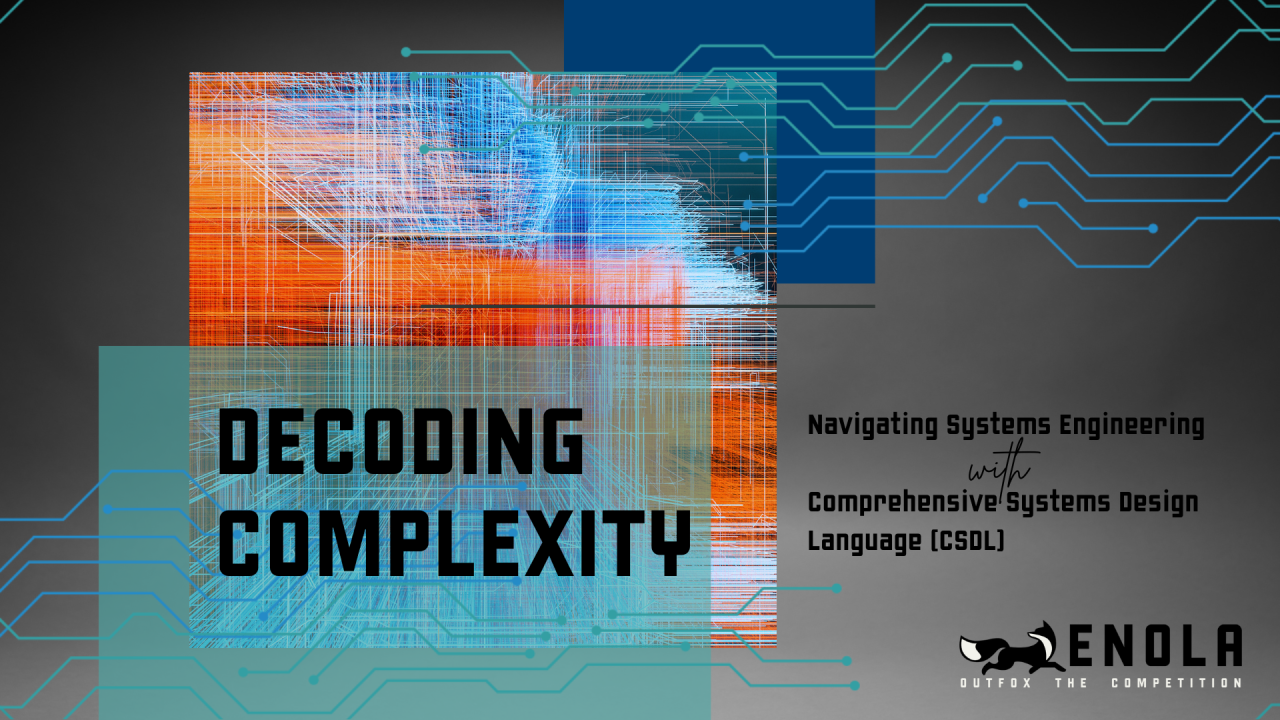
Decoding Complexity: Navigating Systems Engineering with Comprehensive Systems Design Language (CSDL)
In the ever-evolving world of systems engineering, the ability to clearly define, analyze, and present complex systems remains at the core of successful projects. With the introduction of the Comprehensive Systems Design Language (CSDL), professionals are gaining a framework that not only enhances clarity but also strategically simplifies the journey from problem identification to solution delivery. But what does this mean for the broader systems community, and why does it matter now more than ever?
The Essence of CSDL: A Language for Systems Engineers
The CSDL framework offers a structured approach to designing systems by dividing them into manageable domains. This language operates across four primary domains: Requirements, Behavior Architecture, Physical Architecture, and Verification. Each domain plays a vital role in ensuring that systems are designed, understood, and tested with precision.
By breaking down system designs into distinct components, CSDL reduces ambiguity, fosters deeper insights, and increases the accuracy of decision-making at every level. For example, a system’s requirements, from the outset, must reflect the stakeholder’s needs and later evolve into components that engineers can evaluate and verify. This layered methodology provides a roadmap to move from abstract ideas to concrete, executable plans, emphasizing both functionality and validation.
A Layered Approach with STRATA
One of the standout elements within the CSDL framework is the STRATA approach. This multi-layered method helps engineers focus on solving problems by increasing the level of detail with each iteration. STRATA represents a journey—a progressive detailing of system elements that removes uncertainties and fine-tunes solutions.
Through this layered perspective, engineers can manage complexity by breaking it down into its most manageable parts. Requirements are handled with care, physical components are mapped clearly, and the behavior of the system is scrutinized before solutions are locked into place. As each layer is addressed, the system’s design moves from broad strokes to a more detailed, verifiable representation of reality.
Entity-Relationship-Attribute (ERA): A Simplified Data Modeling Approach
A critical aspect of CSDL is its application of the Entity-Relationship-Attribute (ERA) model, fundamental to understanding the interplay between system elements. The ERA approach offers a straightforward method for organizing data and relationships in a way that minimizes redundancy and maximizes data integrity.
Entities represent the core parts of a system, relationships define how these parts interact, and attributes provide the characteristics that make these entities unique. This method ensures that the data architecture remains clean, scalable, and robust, even as the complexity of the system grows.
领英推荐
Real-World Example: Modeling Unmanned Aerial Systems (UAS)
An Unmanned Aerial System (UAS) offers a tangible example of how CSDL works in practice. Using tools such as GENESYS, system engineers model a UAS by first defining its requirements and components and then moving into specific use cases and functions. This detailed breakdown allows engineers to follow the system from concept through to its behavior and physical architecture.
In this case, elements such as navigation subsystems are modeled using block diagrams, showing the physical links between components. Flow diagrams demonstrate the interaction between parts, and behavior diagrams reveal the actions the system will perform under various conditions. These representations allow stakeholders to visualize the system in operation, offering insights into functionality before moving forward with production.
Building Trust Through Verification
No system can be considered complete without a thorough verification and validation process. In systems engineering, this step ensures that the product meets the requirements and functions as expected. CSDL’s verification mechanisms help engineers compare the designed system to the specified requirements, ensuring no detail is overlooked.
The iterative nature of CSDL encourages continuous refinement and validation, ensuring that each phase of the project aligns with the goals set out in the requirements stage. In doing so, the process builds trust—both within the engineering team and with external stakeholders.
Conclusion: The Future of Systems Design
CSDL represents more than just another systems engineering tool—it symbolizes a shift in how we think about and approach complex systems. In an industry where precision is paramount, having a language that helps engineers navigate through ambiguity, complexity, and scale is invaluable.
For professionals looking to refine their systems engineering skills, mastering CSDL offers the potential to increase clarity, drive better communication, and, ultimately, produce systems that are not only functional but innovative. In a world driven by technology and interconnectivity, systems engineering remains the cornerstone of progress, and CSDL provides the language we need to push boundaries further.
Credit to Sarah Rudder, PE, CSEP, OCSMP for her original presentation on 'Understanding and Applying the Comprehensive Systems Design Language (CSDL)' presented at the 2024 INCOSE Western States Regional Conference.
#OutfoxTheCompetition #SystemsEngineering #CSDL #ComprehensiveSystemsDesignLanguage #EngineeringDesign #ModelBasedSystemsEngineering #STRATAApproach #UAS #UnmannedAerialSystems #InnovationInTech #TechnologyLeadership #SystemsThinking #EngineeringInnovation #DataModeling #TechTrends #DesignThinking #EngineeringSolutions #DigitalEngineering #SystemsArchitecture #TechInsights #ComplexSystems #ProcessOptimization #FutureOfEngineering #INCOSE #INCOSEWSRC
Systems Engineering Consultant(Top Voice) | Aerospace and Space Blogger & Science Communicator| Digital Transformation | Women in STEM Advocate | UAE GoldenVisa Holder
1 个月Interesting approach, would like to get more details
Senior Innovation Consultant
1 个月This is well aligned with Model Based Cybertronics Systems Engineering methodology. Here are some tenets 1. Separating SW Tech Stack from HW configurations (FPGA, 3D, ASIC, Accelerated Processors) in the Logical Architectural View allows trading off Capacity, Compute and Data Comms from System to Sensor to IC Board levels 2. The MBCSE approach can be used with different Requirements Tracking tools so you can avoid vendor lock-in. 3. This approach should enable V&V/T&E at all levels and aligns well with recommendations from DSB T&E report. This includes segmenting Software layers including App layer, OS, firmware, hardware, etc. The MBCSE approach is aligned with CSDL AND DSB Report for T&E Derek Woods, M.E., MBA Aleczander Jackson Vito Errico Bernie Gauf Donald Reago Dr. David Gorsich Dinesh Verma Matt MacGregor Raymond Jorgensen